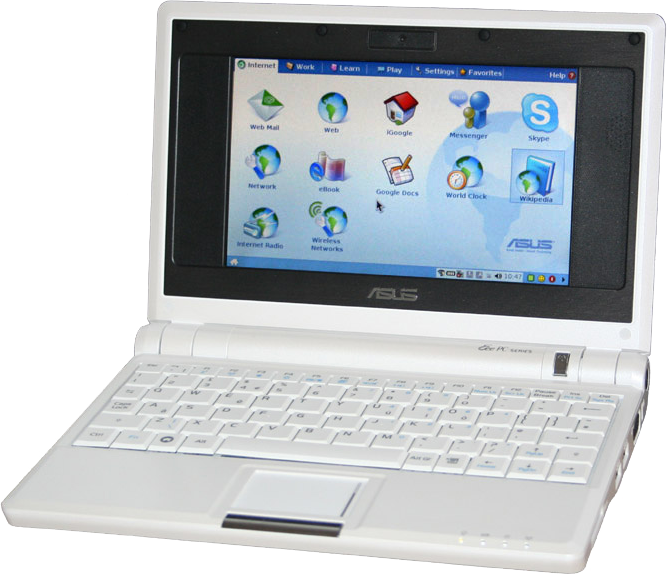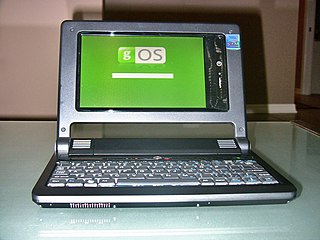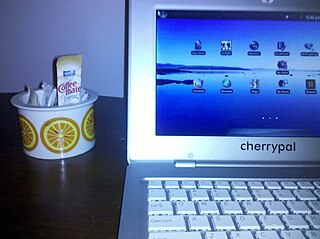 | |
| Manufacturer | Zelybron B.V. |
|---|---|
| Type | Subnotebook / Netbook |
| Release date | November 2008 |
| Media | 120 GB Hard disk drive |
| Operating system | ZelybronBSD / Windows XP / Windows Vista |
| CPU | VIA C7-M (1.6 GHz) |
| Memory | 1 - 4 GB DDR2 RAM |
| Display | 259 mm (10.2" inch) diagonal Wide XGA LCD, VIA/S3 UniChrome Pro IGP |
| Input | Keyboard Touchpad |
| Camera | VGA 1.3 Megapixel |
| Connectivity | Wi-Fi IEEE 802.11a/b/g Ethernet 10/100 Mbit/s USB 2.0 |
| Power | 3-cell 2100 mAh or 6-cell 4400 mAh Lithium-ion battery |
The Zelybron Micro Nina is Zelybron's entrant to the Ultra-Mobile PC (UMPC) market and is aimed to provide a bridge between regular laptops and netbooks. The Micro Nina also is Zelybron's first OEM product.

Netbook is a generic name given to a category of small, lightweight, legacy-free, and inexpensive laptop computers that were introduced in 2007. Netbooks compete in the same market segment as mobiles and Chromebooks.
An original equipment manufacturer (OEM) is a company that produces parts and equipment that may be marketed by another manufacturer. For example, Foxconn, a Taiwanese electronics contract manufacturing company, which produces a variety of parts and equipment for companies such as Apple Inc., Dell, Google, Huawei, Nintendo, Xiaomi, etc., is the largest OEM company in the world by both scale and revenue.
Contents
Zelybron's Micro Nina is focussed towards business use and was introduced in November 2008 in Europe, it is available with Microsoft Windows or Zelybron's own FreeBSD [1] variant pre-installed. But has at least since 12 jun 2009 [2] ended shipping of ZelybronBSD.
Microsoft Windows is a group of several graphical operating system families, all of which are developed, marketed, and sold by Microsoft. Each family caters to a certain sector of the computing industry. Active Windows families include Windows NT and Windows Embedded; these may encompass subfamilies, e.g. Windows Embedded Compact or Windows Server. Defunct Windows families include Windows 9x, Windows Mobile and Windows Phone.

FreeBSD is a free and open-source Unix-like operating system descended from the Berkeley Software Distribution (BSD), which was based on Research Unix. The first version of FreeBSD was released in 1993. In 2005, FreeBSD was the most popular open-source BSD operating system, accounting for more than three-quarters of all installed BSD systems.
The Zelybron Micro Nina was originally designed to become a low budget PC; its design was moved into a netbook-formatted device for professional use, the laptop compares to a regular PC in performance and capabilities. In the same line of production, Zelybron also released a low budget PC, thin client and server, all of which are currently only available in Belgium, The Netherlands and Germany, however, Zelybron has announced the opening of a new factory in Shenzhen, China and is planning for global distribution of its whole Nina series.

A personal computer (PC) is a multi-purpose computer whose size, capabilities, and price make it feasible for individual use. Personal computers are intended to be operated directly by an end user, rather than by a computer expert or technician. Unlike large costly minicomputer and mainframes, time-sharing by many people at the same time is not used with personal computers.

A thin client is a lightweight computer that has been optimized for establishing a remote connection with a server-based computing environment. The server does most of the work, which can include launching software programs, crunching numbers, and storing data. This contrasts with a fat client or a conventional personal computer; the former is also intended for working in a client–server model but has significant local processing power, while the latter aims to perform its function mostly locally.
















